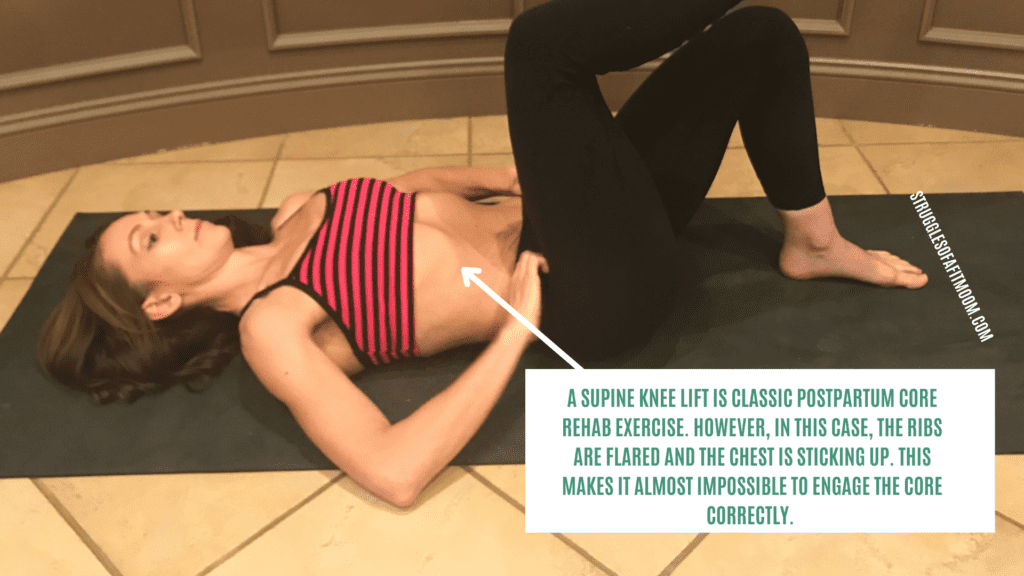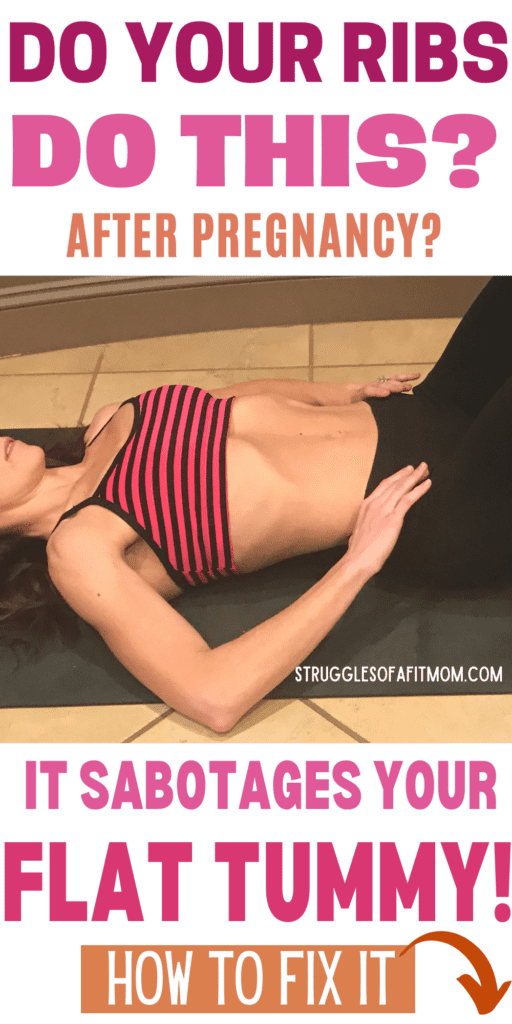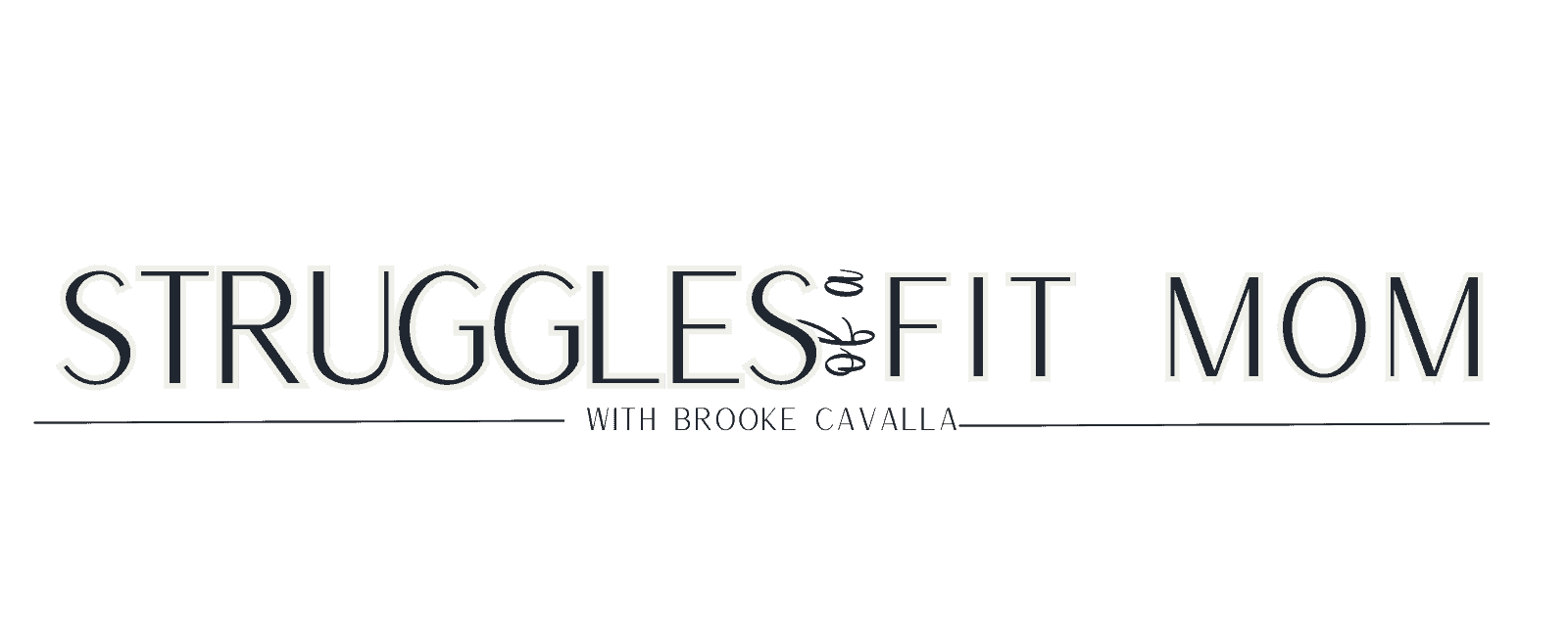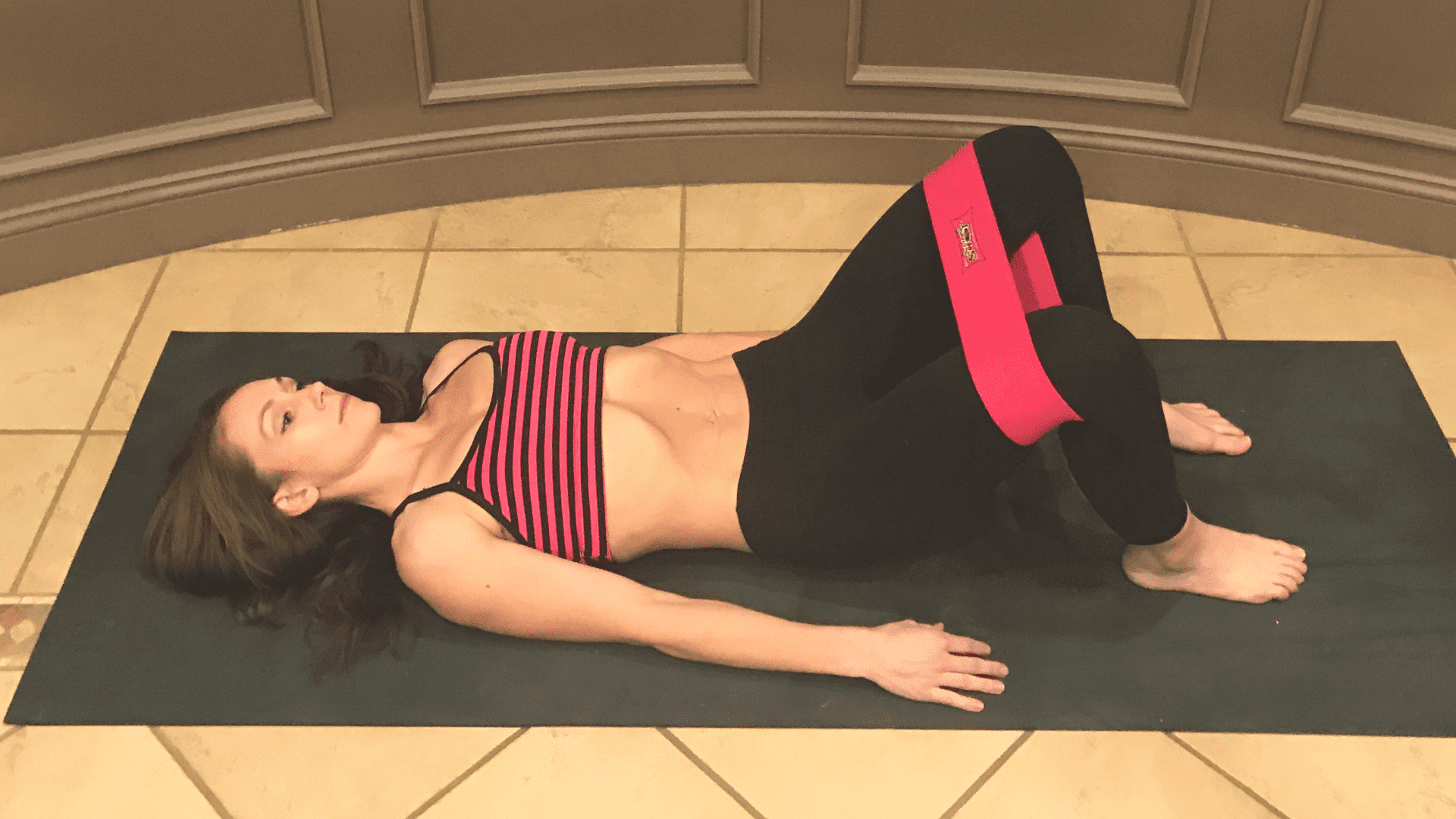Correcting Rib Flare – The Sneaky Saboteur of Your Flat Tummy
(This post probably contains affiliate links. I receive a small commission at no cost to you through links shared on this website to help keep the information I provide free to you)
Inside: Can’t strengthen and tighten your tummy postpartum? This could be why! Rib flare is an overlooked issue that could be making it (almost) impossible to build a strong, functional core. Learn what it is and how to fix it.
Today I want to talk about something that can have a huge impact on your postpartum body but isn’t talk about enough-
Rib Flare.
You may have landed here because you are trying to figure out why the bottom of your rib cage sticks out or no matter what you do, you cannot seem to build a strong, functional core.
This sneaky little saboteur alters proper breathing mechanics, causes low back pain, poor posture, incontinence and a “mummy tummy”.
Restoring your core strength is postpartum is no easy feat and it’s essential to understand how the position of your rib cage affects breathing mechanics and core strength.
A strong, functional core is crucial for proper breathing mechanics, and conversely, proper breathing mechanics are essential for a functional core.
Pesky symptoms arise when these two are out of sync.
So, let’s dive into how to address and fix rib flare so you can finally start building a strong, functional core!
Disclosure: Although I am a certified prenatal/postnatal exercise specialist and personal trainer, I am not YOUR trainer. The content on this blog is for informational purposes only and should not be a substitute of the information and advice you receive from a healthcare professional. This website does not replace the medical advice you receive from your provider.
Understanding Rib Flare
Have you noticed that since after pregnancy your ribs feel wider and the bottom of the ribcage sticks out more than before?
They may even become more pronounced when doing certain exercises such as an overhead press or in day-to-day activities such as doing your hair or lying flat on your back.
This is referred to as “rib flare” and it is usually a sign of a break in core engagement and stability.
When the ribs flare out, the diaphragm is in a suboptimal position to work in conjunction with the core and pelvic floor to manage intra-abdominal pressure.
The back becomes arched, the pelvis tilts forward and this typically causes a domino effect on things such as poor posture, pelvic floor dysfunction, low back pain, and weak core muscles and glutes.
You may notice it is more prominent on the left side of the body because this is where your internal organs sit and the diaphragm attaches lower on the right side.
It is important to note that there a several causes of flared ribs such as “pectus excavatum” which is a deformity in the chest wall that causes the ribs to flare.
For the sake of this post, we are discussing rib flare related to postural changes during pregnancy and postpartum. However, the exercises and stretches can be used if you have never been pregnant but have flaring of the ribcage.

What Causes Rib Flare?
While there are several cases of rib flare, for the sake of this post, we are going to talk about how pregnancy affects your ribs and alignment.
Postural Changes During Pregnancy:
The most common causes of rib flare that I see is from pregnancy.
During pregnancy, the ribcage widens and lifts upward as the internal organs are pushed up to make room for the growing baby.
The rib angle known as the “infrasternal angle” of the ribcage widens which also takes the core muscles and diaphragm along for the ride.
Breathing becomes shorter and more shallow as the pregnancy progresses due to anatomical changes, hormones, blood volume changes and changes in heart rate.
This can further cause accessory muscles such as the neck and shoulders to take over the role of breathing in order to lift and lower the ribcage to allow for inhalation and exhalation.
The ribs can remain in a flared position after pregnancy, making it difficult to fully heal your core and pelvic floor.
Waist Trainers or Staying in a Constant State of Sucking in Your Core
Using a waist training or constantly sucking in your stomach redistributes your organs and core pressure up into the chest cavity or down onto the pelvic floor.
The causes both flared ribs and pelvic floor symptoms such as incontinence, prolapse and/or pelvic pain.
Stress and Anxiety
Stress and anxiety can cause poor breathing patterns by either breathing too shallow or too fast.
Constant chest breathing or tightness in the neck and shoulders can cause the ribs to flare.
Shallow breathing can increase feelings of stress making it even harder to fix.

Related: Postpartum Waist Trainers: Are They Doing More Harm Than Good?
Why Should You Fix Rib Flare?
So other than aesthetic reasons, why is rib flare bad?
Many functions in the body rely on the diaphragm and the position of your ribs.
Flaring of the ribs throws off proper alignment of the entire body making it very difficult to heal Diastasis Recti, strengthen your core after pregnancy, heal lumbar spine pain or stop urinary incontinence.
Muscle imbalance can cause compensation in other parts of the body which may lead to even more pain or dysfunction.
It also places a lot of unnecessary strain on the neck and upper chest and can stress the central nervous system.
Related: 5 Exercises To Do If You’re Tired Of Leaking After Pregnancy
Why Is Rib Flare Bad?
When it comes to healing your core after pregnancy, rib flare can make it more challenging because it can cause:
Impaired breathing mechanics
Because the rib cage houses the diaphragm, a wide rib cage can make it very difficult for the diaphragm to work synergistically with the core to regulate something called “intra-abdominal pressure.”
When the ribs are flared, the diaphragm remains in a constant state of inhalation which makes it almost impossible for it to descend in order to get a to a full exhale.
The inability to regulate pressure within the abdominal cavity cause symptoms such as incontinence, pelvic organ prolapse or back pain.
Disconnection of the Diaphragm, Core and Pelvic Floor
It is essential that the ribcage, diaphragm, pelvis and pelvic floor muscles work in synergy to help stabilize the spine and regulate excess pressure down onto the pelvic floor which causes symptoms such as incontinnce or in more severe cases, pelvic organ prolapse.
The abdominal muscles attach to the bottom of the ribcage and when the ribs are flared, it causes the core muscles to become stretched and weakened.
The zone of apposition refers to the relationship between the ribcage and the pelvis and it is important for efficient breathing mechanics and core recruitment for physical activities such as lifting something heavy or exercising.
When this relationship is thrown out of alignment, it causes poor activation and recruitment of the abdominal muscles and pelvic floor tightness.
Weak Core Muscles or Inability to Heal Diastasis Recti
Your core muscles attach to the diaphragm.
Flared ribs causes constant tension on the core muscles and the linea alba which is connective tissue between the recuts abdominis muscles (aka-the 6-pack muscles),
This can make it very difficult or impossible to heal Diastasis Recti or strengthen your core after pregnancy because the muscles are being stretched.
Poor Posture and Anterior Pelvic Tilt
When the ribs are thrusting forward, the thoracic spine (upper back) becomes hyperextended which can further weaken back muscles.
Weak back muscles can then lead to all sorts of issues from chronic neck and back pain, poor posture and an anterior pelvic tilt (think sticking your butt out).
This is problematic because the hip flexors and low back extensors become tightened which then causes weak abdominal and glute muscles.
Upper Back Pain and Poor Shoulder Mobility
When the upper back muscles are in a constant state of extension (think shoulder blades retracted and chest sticking out), shoulder mobility and stability can become compromised.
This then causes the lower trapezius and serrates anterior muscles to weaken which not good for shoulder health.
Now you can see how everything is connected!

How To Tell if You Have Flared Ribs
The most obvious sign of rib flare is a noticeable protrusion of the bottom of the ribs that gets worse when you lift your arms up.
The angel of the ribcage referred to as the infrasternal angle.
When this angel is wide as a result of pregnancy, it can weaken the abdominal muscles because they are stretched. This also impacts proper diaphragmatic breathing.
However, it is important to note that having a wide infrasternal angle does not necessarily mean that you will automatically have challenges with core strength or rib flare.
It is possible to improve core strength and minimize rib flare by releasing tight muscles and using specific exercises to improve muscle imbalance and restore optimal breathing patterns.
Other possible signs of fared ribs are lower back pain and an anterior pelvic tilt, both of which are often a result weak abdominal muscles.

Ok, So How Can You Fix Rib Flare?
The good news is that in most cases, rib flaring can be fixed.
The best ways to treat flared ribs is to strengthen the core muscles, repair poor breathing patters and release tight muscles in the upper body.
If rib flare is the result of other health issues such as pectus carinatum which is usually diagnosed in young patients or pectus excavatum, then you may need to speak to a specialist who can guide you in the right direction.
If you feel shortness of breath or chest pain, always speak to your healthcare provider or seek immediate medical attention to rule out any possible life threatening conditions.
Rib Flare Stretches
Your ribs need mobility just like any other muscle or joint in the body.
Release tightness in the upper neck muscles, chest and lats with these stretches and myofacial massaging.
Think of myofacial release as breaking up stiff fasica so muscles can move more easily
Teapot stretch
- Begin by standing on your knees.
- Place your right hand on your right rib.
- Take a big inhale and as you exhale, gently press into your ribcage as you bend your body to the right side.
- Now hold this position and take another deep inhale and try to get air all through your ribs and as your exhale, press a little more.
- This helps create mobility on the opposite side of the ribcage.
- Do 2 sets of 1-2 minutes on each side.
Foam Roller Chest Stretch
- This is one of my favorite stretches postpartum to stretch tight chest muscles from holding a baby or breastfeeding.
- Begin by lying face-up on the ground with a foam roller running vertically down your spine.
- Bend your knees with your feet flat on the floor.
- Lift your arms and make them into a goal post position with your elbows and 90 degrees.
- You will likely notice your upper abdomen pops up as you lift your arms over your head.
- Focus on keeping your spine against the foam roller. You can imagine drawing your belly button to spine but not sucking in because this will make your ribs flare.
- Allow your shoulders to relax and you should feel a stretch across your chest and shoulders as well as a little muscle tension release in your back.
- Hold for 15-30 seconds then slowly bring your arms down.
- Repeat 2-3 sets.
Upper Neck and Trap Stretch
- Start by sitting or standing with your back straight and shoulders relaxed.
- Place your right hand over your head and gently pull your right ear toward your right shoulder.
- Keep your left shoulder relaxed and hold for 15-30 seconds.
- You can rock your head back and forth to stretch the entire neck area.
- Repeat on the left side.
Puppy Pose- Mid Back and Lat Stretch
- Begin on your hands and knees in a tabletop position.
- Take a good inhale and as you exhale, slowly walk your hands forward a few inches and lower your chest toward the ground and place your elbows on the blocks. Keep your hips high and directly over your knees.
- Keep your arms extended forward with your palms and forehead resting on the ground.
- Gently press your hands into the ground to lift your forearms of the ground and draw your shoulders down away from your ears.
- Hold for 30 seconds and repeat 2-3 sets.
- This is a great stretch for tight lats and the mid back.
Seated Side Stretch
- Begin by sitting on the floor with your legs crossed.
- Inhale and reach your right arm up over your head and on the exhale, reach your arm over your head like a rainbow.
- Your opposite arm should be relaxed either on your lap or the floor.
- Your should feel the stretch all through your outer rib cace and into the lat muscles.
- Keep your spine long throughout the stretch ad avoid hunching or rounding your shoulders. Hold for 5-10 slow breaths, allowing each breath to get a little deeper.
- Return to center and repeat on the other side.
Lat Release-Foam Roller
- Lie on your right side with your body straight and a foam roller placed under your right armpit, perpendicular to your body.
- Engage your core muscles and gently roll your body back and forth over the foam roller, running it along your lat muscle.
- When you find a tender spot or knot, stop rolling and hold pressure on the spots for 20-30 seconds.
- Release and continue rolling in slightly different angles to find more knots.
- Continue for 1-2 minutes then switch sides.
Acupoint Ball Neck Release
- Begin by standing, facing a door frame with your feet-shoulder width apart.
- Place the Acupoint ball between your upper trap muscle and door frame.
- Gently lean forward into the ball and door frame to use your body weight to apply pressure.
- Move your body to allow the ball to roll up and down the muscle, searching for tenderness or knots.
- When your a find a tender spot or a knot, stop and hold the pressure on that spot for 20-30 seconds to release the tension.
- Continue this process for 1-2 minutes then switch sides.
- You can also place the ball between your scapula and the wall to release tension in your upper back.
- Make sure to focus on using your breath to help your body relax and release tension.
Corrective Exercises For Rib Flare
For best results, perform these exercises in conjunction with postpartum core rehab exercises several times a week.
And once you master these exercises, it’s time to take it up a notch and really start strengthening your postpartum core!
Diaphragmatic Breathing
- Being lying on your back with your knees bent and feet flat on the floor.
- Place one hand on your chest and one hand on your belly.
- Take a deep inhale and feel your lungs expand and chest lift.
- As you exhale, focus on engaging your deep core muscles by drawing your belly button in and slightly upward while also lifting your pelvic floor muscles.
- Inhale and release your core and pelvic floor and on the next exhale, repeat this same cycle.
- Continue for 3-5 minutes, several times a day.
Progression #1- Lying Overhead Reach
Once you have mastered the diaphragmatic breathing, it’s time to add some movement to breath.
- While lying on your back with knees bent and feet flat on the floor, place a yoga ball between your hands and straighten your arms above your head while gently squeezing the ball.
- On an exhale, draw your lats down as you slowly lower your arms behind your head as far as you can without your ribs popping up. If this is challenging, you can remove the ball and start with one arm drop at at time.
- Lower as far as you can until you feel movement in your back or ribcage then hold this position while focusing on drawing the ribs down.
- Return to the starting position.
- Remember, your ribs will want to flare when you lift your arms up so it is important to focus on keeping them down in the optimal position.
- Continue 10-12 reps.
Progression #2 Lying Overhead Reach With Knees Up
- Complete the same exercise as above but with your feet off the floor and knees bent at a 90-degree angle. Your shins should be parallel to the ground and stacked directly over your hips.
Progression #3-Dead Bug
- Complete the same exercise as above but now lower your right arm and lift leg at the same time, focusing on keeping your ribs down, core engaged and back flat.

Join the 5000+ other moms who want to be fit and healthy during pregnancy and beyond!
Free 31 Day Daily Checklist to Make Healthy Happen
We Choose Strength over Size!
Wrapping It Up
Well there you have it.
Hopefully this explains why your bras might be fitting a little tighter and you are struggling to heal your postpartum core.
I know how frustrating and confusing it can feel to navigate your postpartum body.
Remember, it’s all about consistency and determination!
Motivation is what gets you started but commitment to your healthy and strength is what keeps you going.
And if you have exhausted all options and resources to heal your body and core after pregnancy and your symptoms still persist, physical therapy may be a great option for you. A physical therapist will be able to do a physical examination to help determine a more specific treatment plan.
Don’t forget to pin this for later!

FACT CHECK
Struggles of a Fit Mom uses only high-quality sources, including peer-reviewed studies, to support the facts within it’s articles. Read my editorial process to learn more about how I fact-check and keep my content accurate, reliable, and trustworthy.
Philadelphia, C. H. O. (n.d.). Pectus Excavatum. Children’s Hospital of Philadelphia. https://www.chop.edu/conditions-diseases/pectus-excavatum
Talasz, H., Kofler, M., Kalchschmid, E., Pretterklieber, M. L., & Lechleitner, M. (2010). Breathing with the pelvic floor? Correlation of pelvic floor muscle function and expiratory flows in healthy young nulliparous women. International Urogynecology Journal, 21(4), 475–481. https://doi.org/10.1007/s00192-009-1060-1

Brooke is a certified Prenatal and Postnatal Exercise Specialist with a Bachelors of Science degree in Kinesiology-Exercise Science. She is also a mom of 3 girls with more than 15 years of experience in health and fitness. Brooke’s goal at Struggles of a Fit Mom is to help motivate, educate and inspire other busy mamas who struggle with finding time, energy and motivation to take care of themselves in the chaos of motherhood.




![Get Rid of Armpit Fat [The Ultimate Guide]](https://www.strugglesofafitmom.com/wp-content/uploads/2020/12/Untitled-design-15.jpg)



